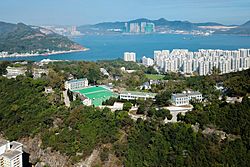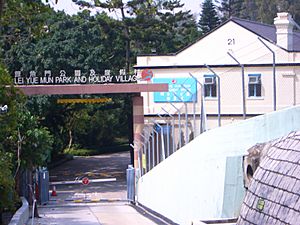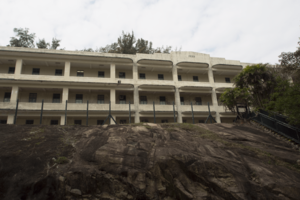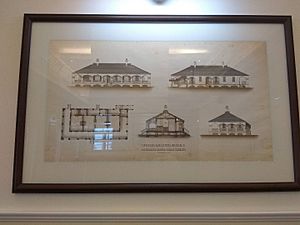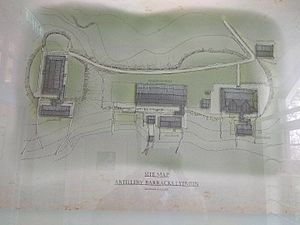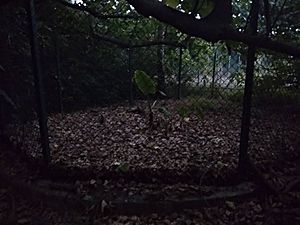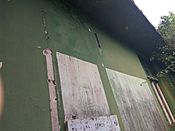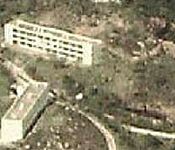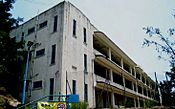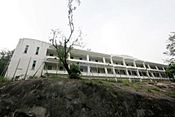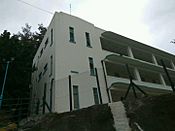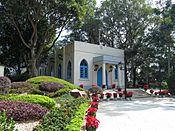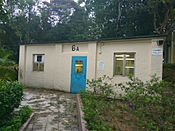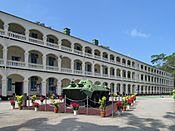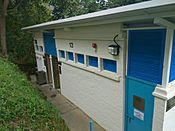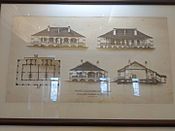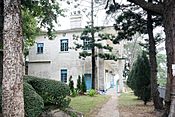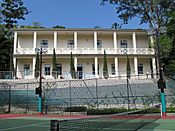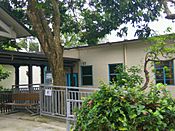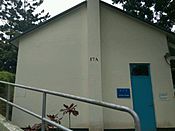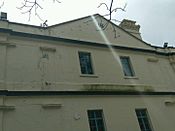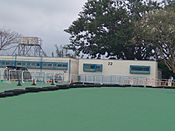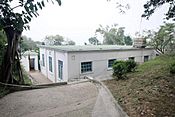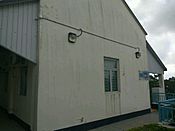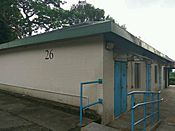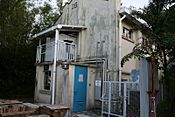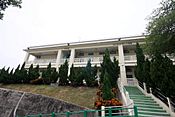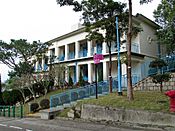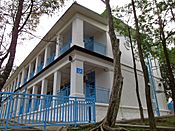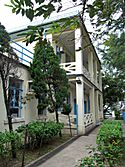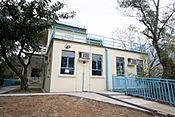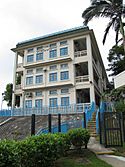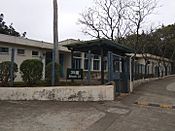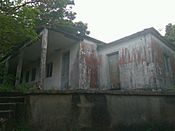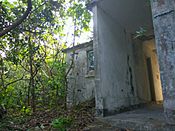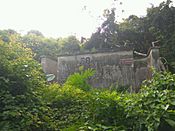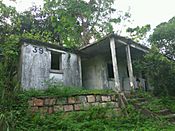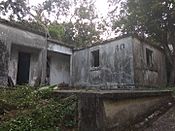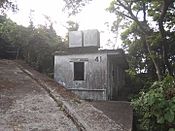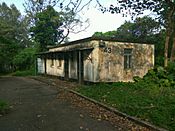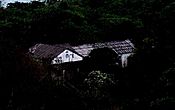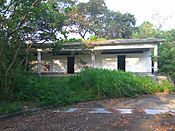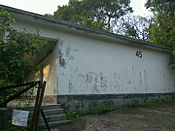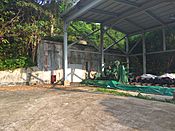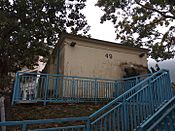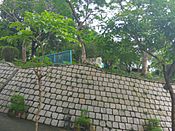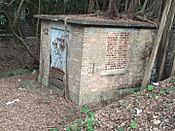Lei Yue Mun Park and Holiday Village facts for kids
| Lei Yue Mun Park and Holiday Village | |||||||||
|---|---|---|---|---|---|---|---|---|---|
| Traditional Chinese | 鯉魚門公園及度假村 | ||||||||
|
|||||||||
The Lei Yue Mun Park and Holiday Village is a fun place for holidays located in the east of Shau Kei Wan, Hong Kong. It faces Lei Yue Mun and covers a large area of about 23 hectares. This special place used to be a military base called Lyemun Barracks. It was home to British soldiers in Hong Kong before it became a holiday village. It's the only government-owned holiday camp in the city areas of Hong Kong.
Contents
History of the Park
Building the Old Barracks
The Lyemun Barracks got its name from the nearby fishing village of Lei Yue Mun. It was one of the first and most important British Army forts in Hong Kong. It was built in a very important spot on Hong Kong Island. From here, soldiers could watch over the eastern entrance to Victoria Harbour.
In 1885, the military decided to build a permanent base here. By 1889, the land was officially given to the War Department for construction. The barracks had three main parts:
- The central area, which is now the Lei Yue Mun Park and Holiday Village.
- The western ridge, known as Upper Fort (Sai Wan Fort).
- The headland, which is now the Hong Kong Museum of Coastal Defence.
World War II and the Barracks
The forts at Lei Yue Mun were very important for coastal defense in the 1890s. They kept growing for many years. However, by the 1930s, new technology and war strategies made them less important.
During World War II, on December 19, 1941, the barracks and the Sai Wan Antiaircraft Battery were taken over by Japanese forces. There were battles as British and Canadian soldiers tried to get the base back, but they were not successful.
From Barracks to Holiday Fun
After the war, the barracks were used by the Hong Kong Military Service Corps from 1948 to 1986. In 1987, the government took over the barracks. They then turned the southern part into the Lei Yue Mun Park and Holiday Village. The headland area later became the Hong Kong Museum of Coastal Defence in 2000.
Because of its long history, the entire former barracks area is now a Grade I historic building. This means it's a very important historical site in Hong Kong. Many individual buildings within the park are also protected as Grade I or Grade II historic buildings.
Helping During Health Outbreaks
The Lei Yue Mun Park and Holiday Village has also played a role in public health.
- SARS Outbreak (2003): In 2003, when SARS spread in Hong Kong, many people got sick. The government decided to move some people who lived near infected areas to isolation. The Lei Yue Mun Park and Holiday Village, along with another holiday village, was used to house these people safely away from others. They stayed there until the health crisis improved.
- Coronavirus (2020): In January 2020, when the COVID-19 virus started to spread from Wuhan, China, Hong Kong also had cases. The government quickly set up the Lei Yue Mun Park and Holiday Village as one of the main places for people to quarantine. This helped to stop the virus from spreading further in the community.
Buildings and Fun Facilities
The holiday village has lots of cool things to do and places to stay.
What You Can Do Here
The park has 4 family hostels and 2 group hostels. These places have balconies, bedrooms, and bathrooms with showers. They can host up to 282 people at once! The park offers many activities, including:
- Rope courses for adventure.
- A horse-riding school with trails.
- Tennis courts.
- Basketball courts.
- Football pitches.
- Many other indoor and outdoor games.
The old buildings where soldiers used to live have been turned into cozy places for campers. Each building, or "block," has a different purpose. For example, Block 10 is the main Recreational Center, and Block 7 is the Coffee Corner.
Old Buildings with New Uses
Since Lei Yue Mun Park and Holiday Village was built a long time ago, its buildings look like European styles from the early 1900s. Most buildings are white with light blue window frames. They are spread out on hillsides and connected by paths.
Many of the old Lyemun Barracks buildings were changed to become part of the holiday village. However, some, like Block 8, an old outhouse near the Coffee Corner, are not used and are closed off.
Block 3, which is across from the Canteen (Block 4), was also unused for a while. In 2016, there was a plan to turn it into a quarantine facility to help stop diseases from spreading. Even though the building was repainted, it's not clear if this plan ever fully happened.
The buildings in the holiday village still have the numbers they were given when they were part of the barracks. These numbers are usually painted on the outside so people can easily tell them apart. Some very old buildings, like Blocks 2, 3, 10, 30, 31, 32, 33, and 34, even have their original building year carved into them.
Renovations and Changes
Between January and July 2018, Block 7, the 'Coffee Corner', was updated. It looks much nicer now! The floor was changed to polished wood, and some walls have dark marble. The lighting was also improved. Inside, you can see drawings that show how the old Royal Artillery Barracks used to look. These drawings help us understand how the buildings were used by soldiers.
For example, the Officers' Quarters (Block 7) used to have many small rooms. Now, the Coffee Corner is one big room with a few smaller ones. These changes were made to fit the building's new purpose as a holiday village.
Hidden Old Structures
There's a road near the Lei Yue Mun Public Riding School that is usually locked. This road leads to other old buildings from the Lyemun Barracks, including the Pak Sha Wan Battery. These areas are not open to the public and are now part of the Hong Kong Museum of Coastal Defense property. They are not well-maintained, with leaves and branches often covering the paths.
Block 1: The Old Changing Room
Block 1 is a green and white building on a small hillside. It used to be a changing room for soldiers who were going to train in a nearby swimming pool. The building is still there, but it's in bad shape. There's broken glass and peeling paint, and the old showering areas are rusty. The swimming pool and two hot tubs nearby are now filled with concrete.
Block 44: The 'Sniper Room'
Other buildings in this isolated area are also in poor condition, like Block 44. It's called the 'Sniper Room' because it looks like a sniper's hideout, with a round window near the roof. This white building is falling apart, with chipped paint and broken floor tiles. The poor state of these unused buildings shows how old the barracks are, especially when compared to the well-kept holiday village buildings.
Important Historic Buildings
The entire Lei Yue Mun Park and Holiday Village area is a Grade I historic site. This was confirmed on December 18, 2009. Some individual buildings within the park are also protected as Grade I or Grade II historic buildings.
On May 20, 2016, three buildings in the Holiday Village were declared official historical monuments. This means they are specially protected by law. These are Block 7, Block 10, and Block 25.
Here is a list of some of the buildings from the former Lyemun Barracks, including their old uses and what they are now:


